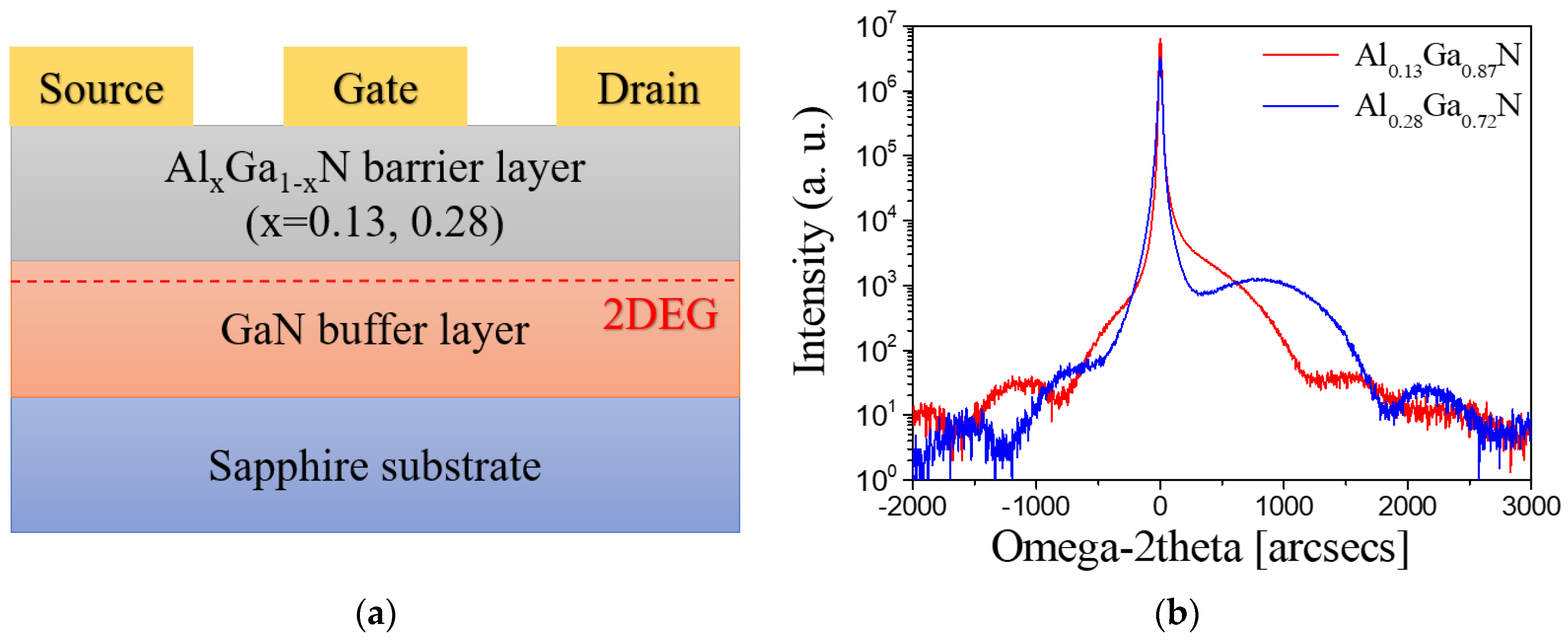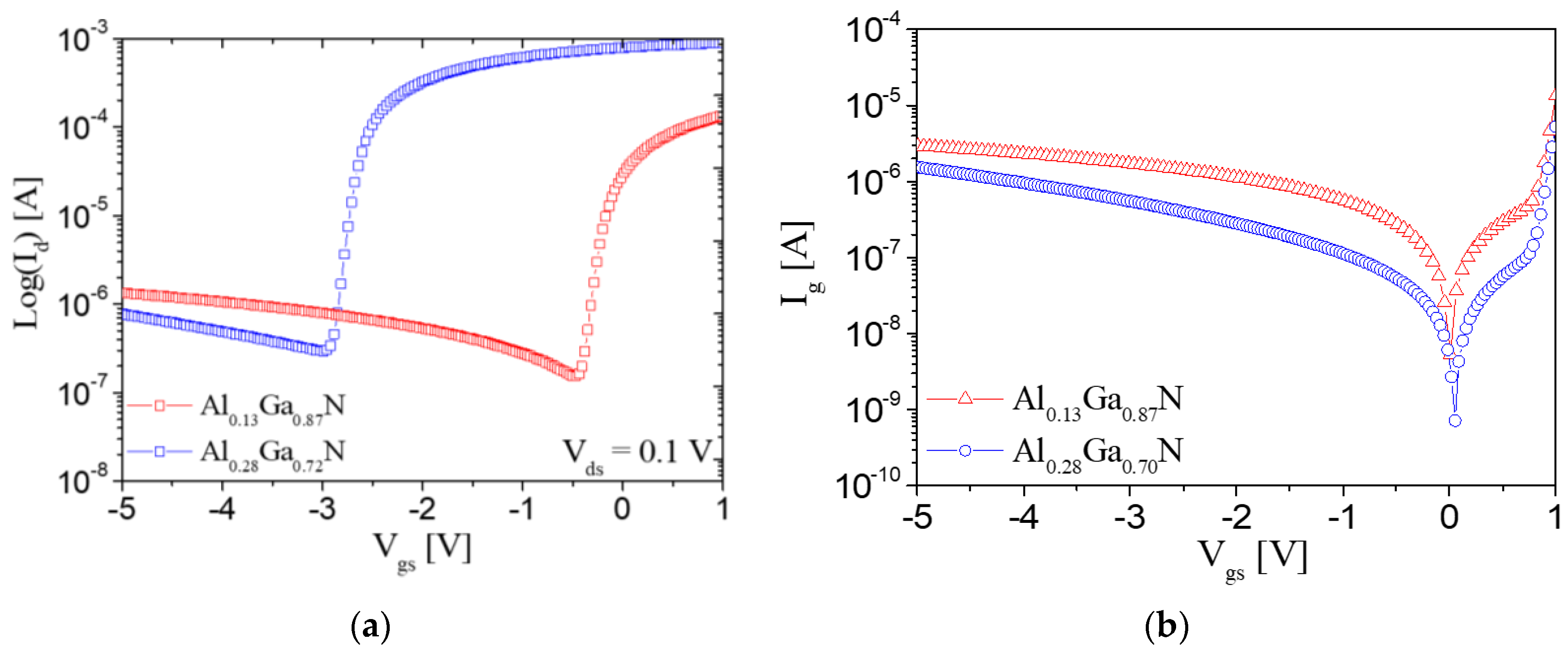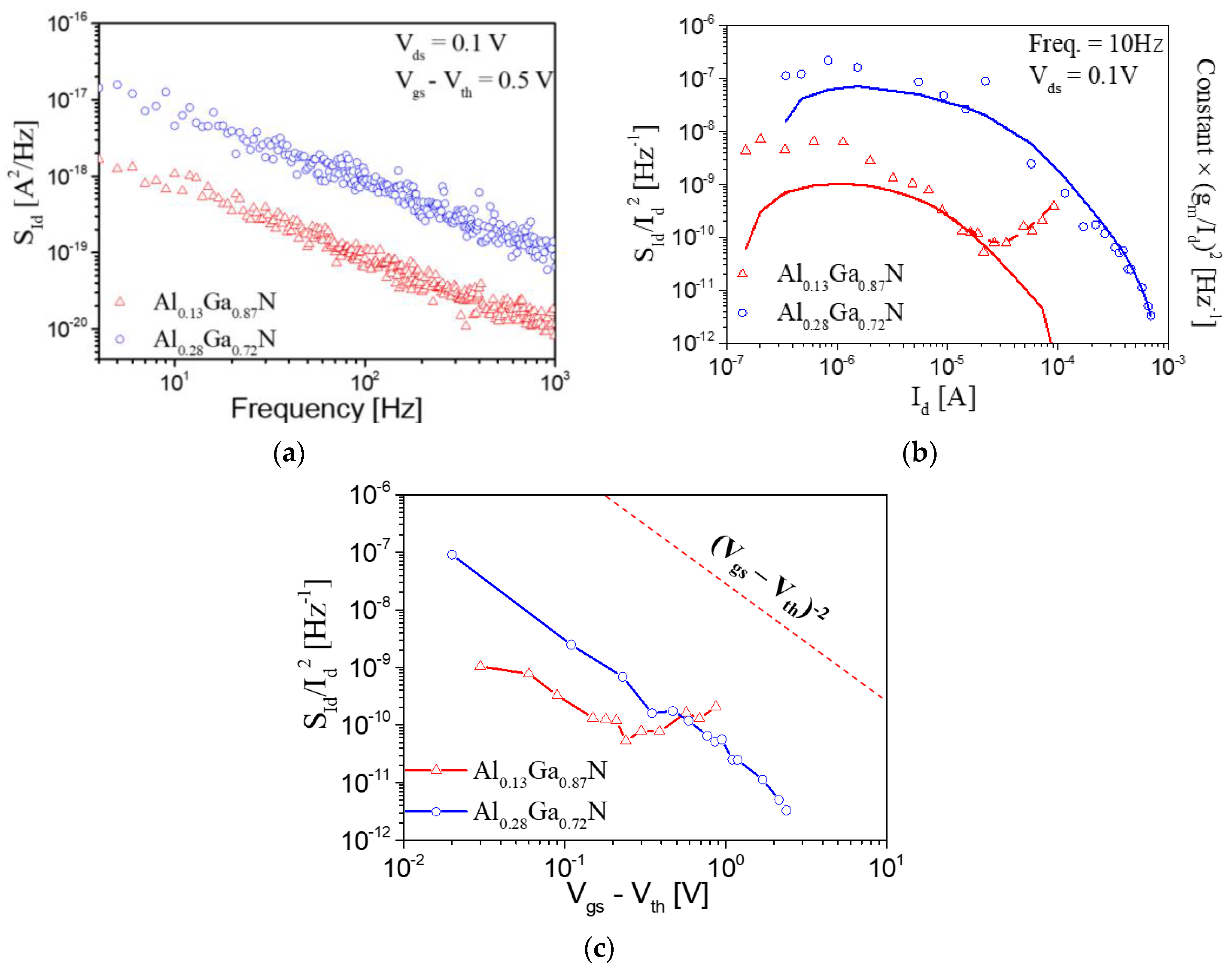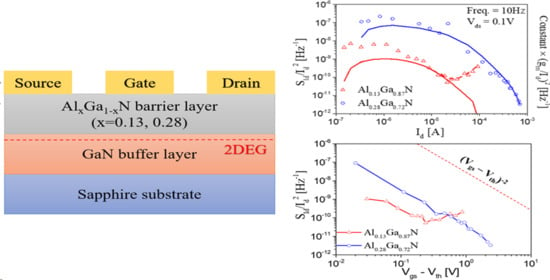Low-Frequency Noise Behavior of AlGaN/GaN HEMTs with Different Al Compositions
Abstract
1. Introduction
2. Materials and Methods
3. Results and Discussion
4. Conclusions
Author Contributions
Funding
Conflicts of Interest
References
- Arulkumaran, S.; Egawa, T.; Ishikawa, H.; Jimbo, T. Characterization of different-Al-content AlxGa1-xN/GaN heterostructures and high-electron-mobility transistors on sapphire. IEEE Electron Device Lett. 2003, 21, 888. [Google Scholar] [CrossRef]
- Nanjo, T.; Takeuchi, M.; Suita, M.; Oishi, T.; Abe, Y.; Tokuda, Y.; Aoyagi, Y. Remarkable breakdown voltage enhancement in AlGaN channel high electron mobility transistors. Appl. Phys. Lett. 2008, 92, 263502. [Google Scholar] [CrossRef]
- Ambacher, O.; Foutz, B.; Smart, J.; Shealy, J.; Weimann, N.G.; Chu, K.; Murphy, M.; Sierakowski, A.J.; Schaff, W.J.; Eastman, L.F.; et al. Two dimensional electron gases induced by spontaneous and piezoelectric polarization in undoped and doped AlGaN/GaN heterostructures. J. Appl. Phys. 2000, 87, 334–344. [Google Scholar] [CrossRef]
- Disanto, D.W.; Sun, H.F.; Bolognesi, C.R. Ozone passivation of slow transient current collapse in AlGaN/GaN field-effect transistors: The role of threading dislocations and the passivation mechanism. Appl. Phys. Lett. 2006, 88, 013504. [Google Scholar] [CrossRef]
- Sai, P.O.; Jorudas, J.; Dub, M.; Sakowicz, M.; Jakštas, V.; But, D.B.; Prystawko, P.; Cywiński, G.; Kašalynas, I.; Knap, W.; et al. Low frequency noise and trap density in GaN/AlGaN field effect transistors. Appl. Phys. Lett. 2019, 115, 183501. [Google Scholar] [CrossRef]
- Hasan, R.; Motayed, A.; Fahad, S.; Rao, M.V. Fabrication and comparative study of DC and low frequency noise characterization of GaN/AlGaN based MOS-HEMT and HEMT. J. Vac. Sci. Technol. B 2017, 35, 052202. [Google Scholar] [CrossRef]
- Rzin, M.; Routoure, J.-M.; Guillet, B.; Méchin, L.; Morales, M.; Lacam, C.; Gamarra, P.; Ruterana, P.; Medjdoub, F. Impact of Gate–Drain Spacing on Low-Frequency Noise Performance of In Situ SiN Passivated InAlGaN/GaN MIS-HEMTs. IEEE Trans. Electron Devices 2017, 64, 2820–2825. [Google Scholar] [CrossRef]
- McWhorter, A.L. 1/f Noise and Germanium Surface Properties in Semiconductor Surface Physics; University of Pennsylvania Press: Philadelphia, PA, USA, 1957; pp. 207–208. [Google Scholar]
- Rzin, M.; Guillet, B.; Méchin, L.; Gamarra, P.; Lacam, C.; Medjdoub, F.; Routoure, J.-M. Impact of the in situ SiN Thickness on Low-Frequency Noise in MOVPE InAlGaN/GaN HEMTs. IEEE Trans. Electron Devices 2019, 66, 5080–5083. [Google Scholar] [CrossRef]
- Do, T.N.T.; Malmros, A.; Gamarra, P.; Lacam, C.; di Forte-Poisson, M.-A.; Tordjman, M.; Hörberg, M.; Aubry, R.; Rorsman, N.; Kuylenstierna, D. Effects of Surface Passivation and Deposition Methods on the 1/f Noise Performance of AlInN/AlN/GaN High Electron Mobility Transistors. IEEE Electron Device Lett. 2015, 36, 315–317. [Google Scholar] [CrossRef]
- Im, K.-S.; Choi, J.S.; Hwang, Y.M.; An, S.J.; Roh, J.-S.; Kang, S.-H.; Lee, J.-H.; Lee, J.H.; Lee, J.H. 1/f noise characteristics of AlGaN/GaN HEMTs with periodically carbondoped GaN buffer layer. Microelectron. Eng. 2019, 215, 110985. [Google Scholar] [CrossRef]
- Loganathan, R.; Jayasakthi, M.; Prabakaran, K.; Ramesh, R.; Arivazhagan, P.; Baskar, K. Studies on dislocation and surface morphology of AlxGa1-xN/GaN heterostructures grown by MOCVD. J. Alloys Compd. 2014, 616, 363–371. [Google Scholar] [CrossRef]
- Jayasakthi, M.; Ramesh, R.; Arivazhagan, P.; Loganathan, R.; Prabakaran, K.; Balaji, M.; Baskar, K. Structural and optical characterization of AlGaN/GaN layers. J. Cryst. Growth 2014, 401, 527–531. [Google Scholar] [CrossRef]
- Ghibaudo, G. New method for the extraction of MOSFET parameters. Electron. Lett. 1988, 24, 543. [Google Scholar] [CrossRef]
- Fieger, M.; Eickelkamp, M.; Koshroo, L.R.; Dikme, Y.; Noculak, A.; Kalisch, H.; Heuken, M.; Jansen, R.; Vescan, A. MOVPE, processing and characterization of AlGaN/GaN HEMTs with different Al concentrations on silicon substrates. J. Cryst. Growth 2007, 298, 843–847. [Google Scholar] [CrossRef]
- Ravinandan, M.; Rao, P.K.; Reddy, V.R. Analysis of the current–voltage characteristics of the Pd/Au Schottky structure on n-type GaN in a wide temperature range. Semicond. Sci. Technol. 2009, 24, 035004. [Google Scholar] [CrossRef]
- Chroboczek, J.A.; Piantino, G. Low Noise Current Amplifier with Programmable Gain and Polarization for Use in Electrical Measurement of Semiconductor Circuits, such as Transistors, with the Circuit Being Low Noise and Having a Protection Circuit for the Input. France Patent No. 15075, 22 November 2000. [Google Scholar]
- Ghibaudo, G.; Roux, O.; Nguyen-Duc, C.; Balestra, F.; Brini, J. Improved Analysis of Low Frequency Noise in Field-Effect MOS Transistors. Phys. Status Solidi A 1991, 124, 571–581. [Google Scholar] [CrossRef]
- Ghibaudo, G.; Boutchacha, T. Electrical noise and RTS fluctuations in advanced CMOS devices. Microelectron. Reliab. 2002, 42, 573–582. [Google Scholar] [CrossRef]
- Im, K.-S.; An, S.J.; Theodorou, C.G.; Ghibaudo, G.; Cristoloveanu, S.; Lee, J.-H. Effect of Gate Structure on the Trapping Behavior of GaN Junctionless FinFETs. IEEE Electron Device Lett. 2020, 41, 832–835. [Google Scholar] [CrossRef]
- Pala, N.; Gaska, R.; Rumyantsev, S.; Shur, M.; Khan, M.A.; Hu, X.; Simin, G.; Yang, J. Low-frequency noise in AlGaN/GaN MOS-HFETs. Electron. Lett. 2000, 36, 268. [Google Scholar] [CrossRef]
- Peransin, J.-M.; Vignaud, P.; Rigaud, D.; Vandamme, L.K.J. 1/f noise in MODFETs at low drain bias. IEEE Trans. Electron Devices 1990, 37, 2250–2253. [Google Scholar] [CrossRef]
- Rumyantsev, S.L.; Deng, Y.; Shur, S.; Levinshtein, M.E.; Khan, M.A.; Simin, G.; Yang, J.; Hu, X.; Gaska, R. On the low frequency noise mechanisms in GaN/AlGaN HFETs. Semicond. Sci. Technol. 2003, 18, 589–593. [Google Scholar] [CrossRef]



| HRXRD | Hall Effect | |||
|---|---|---|---|---|
| Al Composition [%] | AlGaN Thickness [nm] | Rsh [Ω/sq] | μ [cm2/V·s] | ns [cm−2] |
| 13 | 20 | 1923 | 1200 | 0.27 × 1013 |
| 28 | 19 | 421 | 1380 | 1.07 × 1013 |
© 2020 by the authors. Licensee MDPI, Basel, Switzerland. This article is an open access article distributed under the terms and conditions of the Creative Commons Attribution (CC BY) license (http://creativecommons.org/licenses/by/4.0/).
Share and Cite
Choi, Y.J.; Lee, J.-H.; An, S.J.; Im, K.-S. Low-Frequency Noise Behavior of AlGaN/GaN HEMTs with Different Al Compositions. Crystals 2020, 10, 830. https://doi.org/10.3390/cryst10090830
Choi YJ, Lee J-H, An SJ, Im K-S. Low-Frequency Noise Behavior of AlGaN/GaN HEMTs with Different Al Compositions. Crystals. 2020; 10(9):830. https://doi.org/10.3390/cryst10090830
Chicago/Turabian StyleChoi, Yeo Jin, Jae-Hoon Lee, Sung Jin An, and Ki-Sik Im. 2020. "Low-Frequency Noise Behavior of AlGaN/GaN HEMTs with Different Al Compositions" Crystals 10, no. 9: 830. https://doi.org/10.3390/cryst10090830
APA StyleChoi, Y. J., Lee, J.-H., An, S. J., & Im, K.-S. (2020). Low-Frequency Noise Behavior of AlGaN/GaN HEMTs with Different Al Compositions. Crystals, 10(9), 830. https://doi.org/10.3390/cryst10090830





